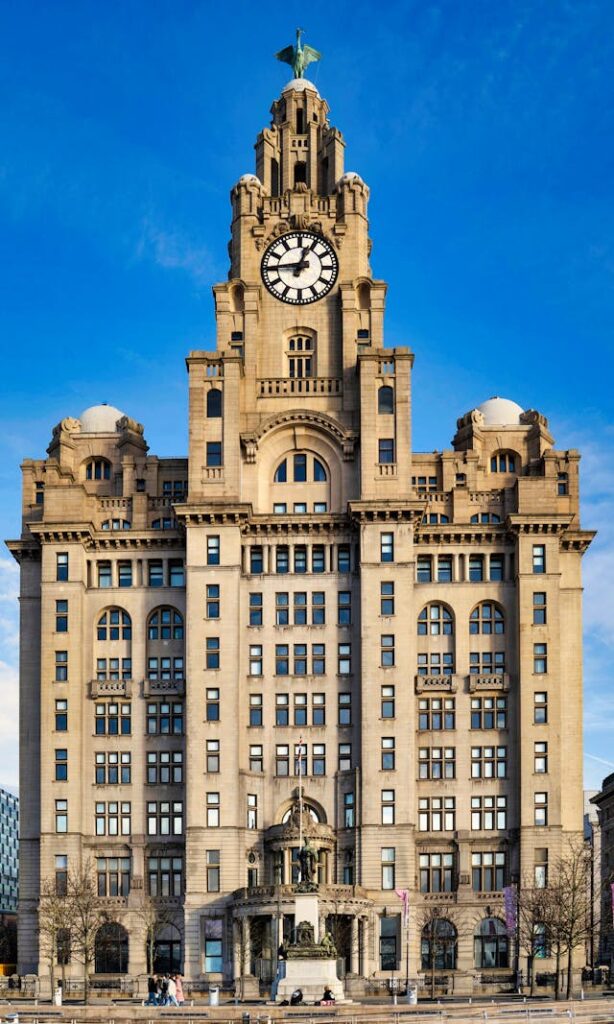Welcome to Liverpool – A City of Culture, Heritage, and Reinvention
Liverpool, a maritime city nestled on the banks of the River Mersey in northwest England, stands as a testament to the power of reinvention and cultural resilience. Once one of the world’s major trading centers, Liverpool has transformed itself into a vibrant cultural destination while maintaining strong links to its seafaring past. This city, with its rich history and dynamic present, offers visitors a unique blend of heritage, music, sport, and contemporary urban life.
The city’s maritime legacy is etched into its very fabric. The Albert Dock, a complex of dock buildings and warehouses first opened in 1846, stands as the largest collection of Grade I listed buildings in the UK. Once a vital part of the city’s trading empire, it now houses museums, galleries, restaurants, and shops. The Merseyside Maritime Museum, located within the Albert Dock, tells the story of the port city, from its days as a hub of the transatlantic slave trade to its role in World War II.
Perhaps Liverpool’s most famous export is its music. The city that gave birth to The Beatles has an unparalleled musical heritage that continues to this day. The Beatles Story museum offers fans an immersive journey through the band’s history, while the Cavern Club, where the Fab Four played some of their early gigs, still hosts live music daily. Beyond The Beatles, Liverpool has produced numerous other influential bands and artists, from Gerry and the Pacemakers to Echo & the Bunnymen and modern stars like The Wombats.

Football is woven into the city’s DNA. Home to two Premier League clubs, Liverpool FC and Everton FC, the city lives and breathes the beautiful game. The rivalry between these two teams, known as the Merseyside Derby, is one of the oldest and most passionate in football. A visit to Anfield, Liverpool FC’s iconic stadium, or Goodison Park, Everton’s home ground, offers insight into the fervor and tradition that surrounds football in the city.Liverpool’s architecture tells the story of its rise, fall, and resurgence. The Three Graces – the Royal Liver Building, the Cunard Building, and the Port of Liverpool Building – dominate the waterfront, symbols of the city’s early 20th-century prosperity. In contrast, modern structures like the Museum of Liverpool and the Liverpool Echo Arena showcase the city’s contemporary ambitions. The Liverpool Cathedral, the largest in Britain, and the modernist Metropolitan Cathedral, affectionately known as “Paddy’s Wigwam,” offer striking examples of ecclesiastical architecture.
The city’s cultural renaissance is perhaps best exemplified by its thriving arts scene. Tate Liverpool, housed in a converted warehouse at Albert Dock, brings world-class modern and contemporary art to the city. The Walker Art Gallery, one of the finest art galleries in Europe, houses an impressive collection spanning six centuries. The Bluecoat, Liverpool’s centre for contemporary arts, showcases emerging talent across various disciplines.
Liverpool’s diversity is reflected in its vibrant neighborhoods. The Baltic Triangle, once an industrial area, has been transformed into a creative and digital quarter, filled with street art, independent cafes, and music venues. Lark Lane, with its bohemian atmosphere, offers a plethora of independent shops, bars, and restaurants. Chinatown, home to the oldest Chinese community in Europe, boasts the largest Chinese arch outside of China.
The city’s renaissance was recognized in 2008 when Liverpool was named the European Capital of Culture. This accolade sparked further regeneration and cemented Liverpool’s status as a major cultural destination. The legacy of this year can be seen in the continued investment in the arts and culture sectors and the city’s growing reputation as a tourist destination.
Despite its modernization, Liverpool has not forgotten its roots. The International Slavery Museum, also located at Albert Dock, offers a sobering look at the city’s involvement in the transatlantic slave trade and its lasting global impact. This unflinching examination of its past demonstrates Liverpool’s commitment to acknowledging all aspects of its history.
Today, Liverpool stands as a city that has successfully bridged its past and future. It honors its maritime heritage while embracing innovation, celebrates its musical legends while nurturing new talent, and cherishes its sporting traditions while looking to future glories. From the Merseybeat to the Mersey Ferry, from the Liver Birds to Liverpool ONE shopping center, the city offers a rich tapestry of experiences that reflect its unique character and enduring spirit.
Whether you’re exploring the historic docks, taking in a match at Anfield, enjoying live music at the Cavern Club, or admiring contemporary art at Tate Liverpool, the city’s energy is palpable. Liverpool’s story is one of resilience, creativity, and reinvention – a narrative that continues to unfold, making it an ever-evolving and exciting destination for visitors from around the world.
